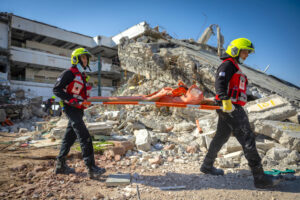(JNS)
Ninety-three percent of all the buildings awaiting reinforcement in northeastern Israeli cities could collapse if an earthquake of sufficient intensity hits, according to an Israeli government report released Tuesday, March 14.
Government ministries and municipal authorities have not done enough to prepare for an earthquake scenario in the five cities of Beit She’an, Tiberias, Safed, Kiryat Shmona and Hazor Hagalilit, the State comptroller’s report found.

Firefighters, Jerusalem Emergency Department volunteers and IDF Home Front Command soldiers take part in a drill simulating a building collapse following an earthquake in Ma’ale Adumim, Feb. 14, 2023. Photo courtesy of Yonatan Sindel/Flash9
Ignoring The Problem
Although the Ministry of Construction and Housing allocated a budget to reinforce the buildings, only 84 (7%) of the 1,208 structures requiring reinforcement had undergone the process.
The report stated that “at this rate it would take decades to complete the reinforcement of all the residential buildings” where there is an “immediate and concrete danger” that they would collapse if an earthquake of sufficient intensity were to strike.
In terms of access to the towns in question should an earthquake take place, three of the four bridges leading to the Beit She’an are expected to collapse. The municipalities of Tiberias, Safed, Kiryat Shmona and Hazor Hagalilit agreed that they, too, would be cut off.
A Warning
Israel has scrambled to improve its earthquake preparedness in the wake of the Feb. 6 quakes in Turkey and Syria that, together with hundreds of aftershocks, killed an estimated 48,440 people in the former and 7,250 in the latter, in what the World Health Organization called the region’s worst natural disaster in a century.
Israeli Prime Minister Benjamin Netanyahu directed National Security Council head Tzachi Hanegbi to “update and reiterate the steps we need to take.”
The Knesset Internal Affairs and Environment Committee called for an emergency meeting, and State Comptroller Matanyahu Englman urged the government not to delay, saying the wave of deadly earthquakes in the region should be viewed as a warning.
History Of Quakes
Experts have stressed that Israel’s earthquake readiness is insufficient. A 2018 report by the previous comptroller estimated that a major earthquake could result in 7,000 casualties and leave 170,000 people homeless. A report from last year found that 600,000 buildings in the country do not meet the standard for earthquake resistance.
Israel is located along the Great Rift Valley, an active geological fault line presenting several significant hazards for the area, including frequent minor earthquakes and the potential for more serious seismic events.
Israel had a long history of earthquakes, with a major one occurring approximately every 100 years. The last major earthquake to hit the country was in 1927. That quake, which had a magnitude of 6.2, claimed 284 lives and injured 940. The epicenter was in the northern Dead Sea area. Jerusalem, Jericho, Ramla, Tiberias, and Nablus were heavily damaged.








